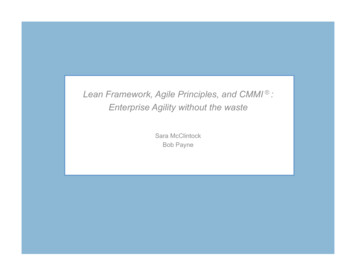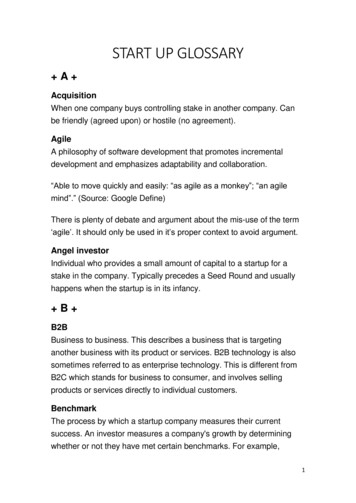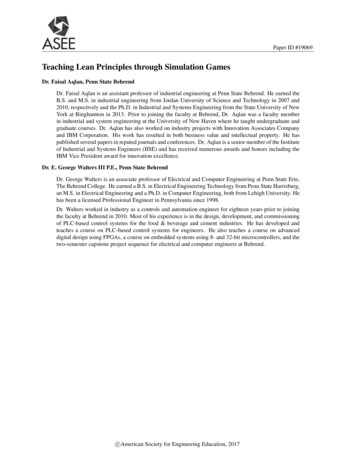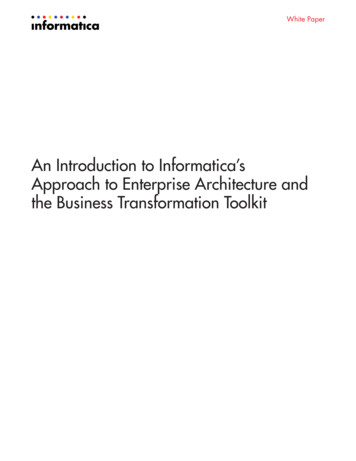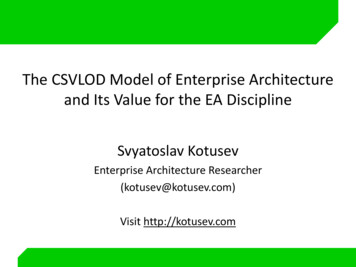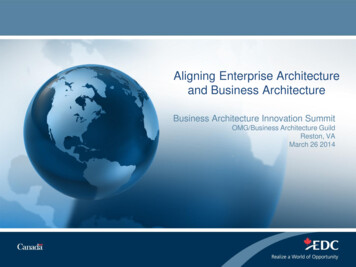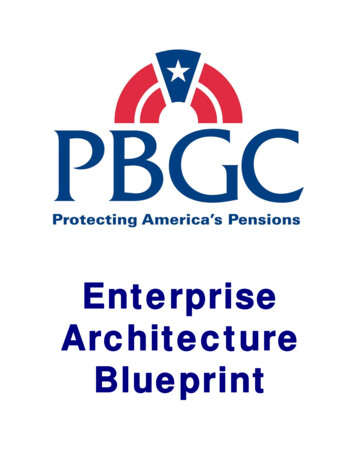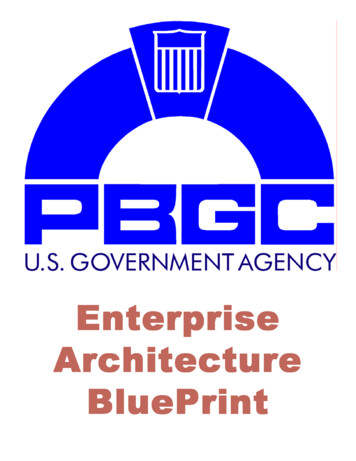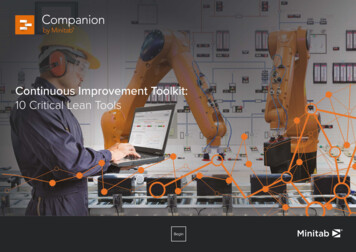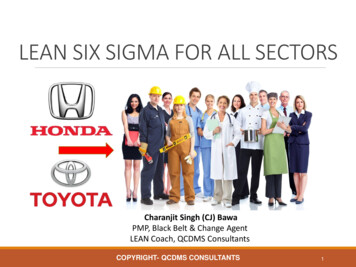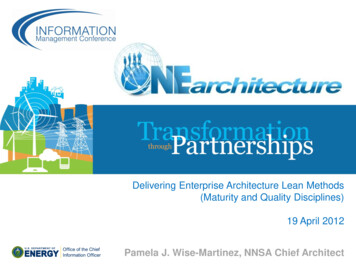
Transcription
Delivering Enterprise Architecture Lean Methods(Maturity and Quality Disciplines)19 April 2012Pamela J. Wise-Martinez, NNSA Chief Architect
Agenda Introduction OneArchitecture concept, goals & alignment Enterprise Architecture Vision for Center of Excellence Road to the OneArchitecture Strategy Ensuring Architecture workgroup alignment with Mission Enterprise Architecture Maturity and Assessment NNSA’s Repository Proposal Accomplishments What’s Next1
IntroductionNNSA’s CIO coined the phraseOneArchitecture (One EA) approach todeliver the enterprise architecture. NNSAEnterprise Architecture (EA) team inpartnership and collaboration with theDepartment’s Enterprise Architects will providearchitecture guidance & support for NNSA’sand Department initiatives. As a result the EAteam developed a LEAN discipline forarchitecture.2
NNSA’s Enterprise ArchitectureCenter of ExcellenceService OrientedPlanning andDesignStrategic Alignmentof Business andTechnologyEngineeringQuality andStandardsMaturity andProcessOptimizationContext Driven,Communicationsand AbstractionValue AddedConsumer Servicesfor Mission SupportSecurity andInteroperabilityFocusedGovernance forEnterpriseInformationArchitectureCommon Business Language3
OneArchitecture DefinitionA Center of Excellence approach,OneArchitecture (One EA) is aLEAN Architecture developmentdiscipline delivering an AsEmerging Enterprise Architecture,Blueprints, Standards andReference Architecture guidancefor business and technologyinitiatives across the enterprise.4
NNSA OneArchitecture ConceptI.One Enterprise Architecture across all of NNSA Sites/M & O’s, Labs, sustained programs, new initiatives Common set of core artifacts, common modeling (TOGAF, SOA and FEA), disciplinesand common business languageII. DOE Strategic EA Partner—Early support of Key InitiativesIII. Aligned with Federal Enterprise Architecture (FEA) v2 Architecture based on Federal Common Approach to Enterprise Architecture(FEA replacement) Federal Shared Services alignmentIV. Align Strategic Investments in Technology to meetBusiness Objectives (CPIC)5
OneArchitecture 2012 GoalsI.Develop Mature EA Framework and RepeatableGovernance Model/ProcessII. Develop and Approve list of Artifacts and Blueprints forfuture projectsIII. Align all Architecture work to EA disciplines and principalsIV. Build EBRM, ETRM, ESRM, ESerRM Technical Standards, Functional Decomposition to Business Processes, Security Profiles and Risk Approach, Application design and engineering standards and Principles6
Delivering OneArchitecture Strategyand scriptiveArchitectureAs-EmergingArchitectureEA Principals,Goals andGuidance rdsManagementDataDescriptionsandDefinitions nologyand BusinessTransformationSOA, TOGAF,FEAJust 12 - 20137
Architecture Domain andWorkgroup ic Alignment(Business Case)DAA-related topicsAdministration oftechnologyApplication/ServicedevelopmentBusiness ProcessEngineeringSSM-related topicsSolution ArchitectureRest and WSDLContracts (Interfaces)Information AssetsAudit/control issuesChange ControlService CataloguesInvestment AlignmentEnterprise Role andContinuous MonitoringInfrastructureComponentsService OrientedArchitecture(Networks, Platforms,Facilities, Access)Performance MetricsPolicy EnforcementIT PortfolioService InventoryIdentity ManagementENTERPRISE LINES OF SITEMaster Data andWorkflow(BRM, DRM, PRM)Information Assurance(SRM)Virtualization(IRM)Shared Services andInformation Exchange(ARM)8
NNSA Enterprise Architecture FrameworkBusAWGSvcAWGServices RAEGMITEAGCTechAWGEnterprise SecurityRAData EABusiness EAIRBTechnology EASecAWGN E AT RArchitectureRepository(TROUX)Work Streams penetrate allworking level architecturesNNSA “segment” Level Architecture ArtifactsArchitectureIntegration PointHQ./Site/M&OArchitecturesNNSA Sustained Program Level Architecture ArtifactsNNSA Project Level Architecture Artifacts“Working level” architectures “pluginto” (i.e. integrate into) theenterprise for completenessProgramArchitecturesNew StartsArchitectures9
NNSA Enterprise Architecture FrameworkBusAWGSvcAWGServices RAEGMITEAGCTechAWGEnterprise SecurityRAData EABusiness EAIRBTechnology EASecAWGN E AT RArchitectureRepository(TROUX)Work Streams penetrate allworking level architecturesNNSA “segment” Level Architecture ArtifactsArchitectureIntegration PointHQ./Site/M&OArchitecturesNNSA Sustained Program Level Architecture ArtifactsNNSA Project Level Architecture Artifacts“Working level” architectures “pluginto” (i.e. integrate into) theenterprise for completenessProgramArchitecturesNew StartsArchitectures10
EA Maturity and Assessment11
Business Architecture WorkgroupGoal: Ensure Business Architecture alignmentwith the enterpriseStrategic Alignment of Business and Technology Identify existing business processes across the enterprise Identify future business processes that will align to mission Identify existing business use cases across the enterprise Identify future business use cases that will align with mission12
Service Architecture WorkgroupGoal: Ensure architecture services are alignedwith enterprise initiatives Applications will be defined in terms of services offered Identify application candidates at each site that can be consolidated orretired Map selected applications to future cloud-aware requirements for Ensure future Cloud aware applications satisfy criteria for Interoperability Performance and scalability Reliability and availability Application and technology insertion lifecycles Technological risks13
Technology ArchitectureWorkgroupGoal: Ensure Technical Architecture alignmentwith enterprise initiatives Primary focus areas include: Cloud Computing Mobility Social Computing Networking Identify existing network diagrams and topologies ateach site Identify Cloud Computing topologies that will align with future businessprocesses14
Security Architecture WorkgroupGoal: Ensure Security Architecture alignment withRightPath initiatives for all architectural domains Business Information Applications Data Technology15
Security Architecture WorkgroupEnsuring OneArchitecture alignment complieswith FedRAMPWhat is FEDRAMP?FedRAMP is a government-wide program that provides astandardized approach to security assessment, authorization,and continuous monitoring for cloud products and services. This approach uses a ―do once, use many times‖ frameworkthat will save cost, time, and staff required to conduct redundantagency security assessments.16
NNSA Enterprise ArchitectureTransformation Repository (NEATR)N E AT RProcesses, Activities, dataDocuments, reports, etcArchitectureArtifactsEG&PExecutionGovernance & Policy FileGovernance&PolicyTSPDiagrams, ical Standards Profile (TSP)StorehouseArchitectureof ALL s) Artifacts,Products, Documents17
OneArchitecture – Recommended Artifacts Artifacts are divided into architecturedomains to build the Enterprise Architecture Business Technology/Infrastructure Application/Service Security Data/Information18
Team Value-Add Accomplishments Developed NNSA OneArchitecture framework and (AsEmerging) Blueprinting Approach Developed list of Artifacts for (Business, Technical, Security,Applications and Data) and Intake process Developed Technical Reference Model- In Review Delivered Business Architecture Project Plan - Complete Delivered Business Architecture Strategy – In Review Developed PPBE IDEF0 Modeling - Collaboration Delivered Enterprise Business Functional Decomposition Complete SOA Assessment Strategy & Reference Model -
Next Steps Perform BA Assessment and discovery for all HQ Programs(SixSigma Assessments) Deliver Enterprise Reference Models and Technology Bricksand Patterns (ETRM, EBRM, SecRM) Deliver Enterprise Troux Strategy Meta-Models, DataMarts, Artifacts, Intake Continue to align with mission and business requirements Plan for Enterprise Architecture Day20
Thank You!Pamela J. Wise-Martinez, CGEITNNSA Chief ArchitectOffice of the Chief Information OfficerU.S. Department of EnergyNational Nuclear Security AdministrationP: a.doe.govNNSA Enterprise Architecture MailboxEAGC@nnsa.doe.gov21
BACKUP SlidesSample of Common FEA v2,TOGAF 9 Artifacts andEA Definitions
Business Architecture ArtifactsArtifactStandardDomainConditionOwner ***CommentBusiness ArchitectureBusiness Reference Model version 2FEA v2 - DeliverableBusinessRequiredEA TeamFederal Enterprise Architecture Reference Model version 2Functional Decomposition DiagramVisioTOGAF 9 Template - Request for Architecture TOGAF 9 - DocumentWorkBusinessBusinessRequiredRequiredEA TeamFunctionalDescribes the functions with the organizationAll IT investments requiring architecture reviewBusiness Process DiagramBusinessRequiredTOGAF 9 Template - Organizational Model for TOGAF 9 - DocumentEnterprise ArchitectureActor Role MatrixTOGAF 9 - DocumentBusinessRequiredBusinessRequiredUse Case Narrative and DiagramUML - VisioBusinessRequiredFunctional/ EA Team Business Process Model Notation version 2.0, OpenManagement Group (OMG)Functional/ EA Team Document to describe the organizational roles andresponsibilities from the enterprise perspectiveFunctional/ EA Team The matrix to describe the organizational roles andresponsibilitiesEA Teamuse case depicts the actors, scenario tied to process modelsTOGAF 9 Template - Business Principles Goals - DriversTOGAF 9 - DocumentBusinessOptional -ThresholdFunctionalTOGAF 9 Template - ArchitectureRequirements SpecificationBusiness Interaction MatrixTOGAF 9 - DocumentBusinessRequiredFunctionalTOGAF 9 - DocumentBusinessRequiredFunctionalInformation Exchange MatrixExcelBusinessRequiredFunctional/ EA Team Information exchange requirements express therelationships across three basic entities (activities,business nodes and their elements, and information flow),and focus on characteristics of the information exchange,such as performance and security. They identify whoexchanges what information with whom, why theinformation is necessary, and in what manner.As-emerging Business ArchitectureOneEA - DeliverableBusinessRequiredFunctional/ EA TeamAs-emerging Business Architecture Definition OneEA - DeliverableDocumentBusiness Inputs to the EAOneEA - DeliverableRoadmap/Transition Plan/Sequencing PlansBusinessRequiredFunctional/ EA TeamBusinessRequiredFunctional/ EA TeamBPMN 2.0Business principles, business goals, and business driversprovide context for architecture work, by describing theneeds and ways of working employed by the enterprise.Requirements Specification document to capture requiredfor the business needdescribes the business locations (nodes), the "needlines"between them, and the characteristics of the informationexchanged
Technology/InfrastructureArchitecture ntTechnology & InfrastructureInfrastructure Reference ModelFEA v2 - Deliverable InfrastructureRequiredEA TeamTOGAF 9 Template - Requirements CatalogNetwork Diagram (voice, data, video, mobile)Network Computing - Hardware MatricesTOGAF 9 Template - Environments and LocationDiagramTOGAF 9 Template - Technology StandardsCatalogTOGAF 9 Template - Technology Portfolio CatalogTOGAF 9 - excelVisioTOGAF 9 - excelOneEA -DeliverableRequiredRequiredRequired - AppendixOptional - AppendixFunctionalFunctionalFunctionalEA TeamOneEA - Deliverable InfrastructureTOGAF 9 - excelTOGAF 9 - excelInfrastructureRequiredEA TeamRequiredFunctionalSystem - Technology to App MatrixTOGAF 9 - excelInfrastructureOptionalTechnology Stack DiagramsOneEA -PatternDeliverableInfrastructure* Required - needsample diagramEA TeamAs-Emerging Technology ArchitectureOneEA - Deliverable InfrastructureRequiredEA Teamas-Emerging Technology Architecture Definition OneEA - Deliverable InfrastructureDocumentRequiredEA TeamTechnology Inputs to the EA Roadmap/Transition OneEA - Deliverable InfrastructurePlan/Sequencing PlansRequiredEA astructureEA team develops and collaborates withstakeholders. Enterprise Technical ReferenceModel(ETRM) in developmentAnalysis and work-study documentTBANetwork physical computingDepicts the application host, location, andequipments of all services (cloud, other)Identify the current and emerging standards asmapped through the portfolio catalogueDeployed technology, logical and physical andplatform layers as related to appropriatedtechnologymaps applications to technologies, sunset dates,versions, etcstack diagram showing how hardware,operating system, software infrastructure, andpackaged applications combine.Develop a Baseline Description of theEMERGING Technology Architecture, to supportthe Target Technology Architecture. The scopeand level of detail to be defined will depend onthe extent to which emerging technologycomponents are likely to be carried over into theTarget Technology Architecture, and on whatarchitectural descriptions exist1. Fundamental functionality and attributes semantic, unambiguous including securitycapability and manageability2. Named interfaces: chosen set, supplied (APIs,data formats, protocols, hardware interfaces,standards)3. Map to business/organizational entities andpolicies24
Application/Service onApplications ArchitectureOwnerCommentApplications Reference ModelFEA v2 - DeliverableApplicationsRequiredEA TeamEA team develops and collaborateswith stakeholders. EnterpriseApplication ReferenceModel(EARM) in developmentTOGAF 9 Template - Requirements CatalogTOGAF 9 - excelApplicationsRequiredFunctionalPhysical Application Components Map toTOGAF 9 - excelOrganization's UnitsTOGAF 9 Template - Application Communication TOGAF 9- ionsRequiredFunctionalAnalysis and work-studydocumentDepicts the applications aligned tothe business unitsDepicts the data that is exchangedbetween applicationsApplication Interaction MatrixTOGAF 9 - excelApplicationsRequiredFunctionalSystem - App to App to Service to system Matrix TOGAF 9 - excelApplicationsRequiredFunctionalSystem - Data MatrixTOGAF 9 - excelApplicationsRequiredFunctionalTOGAF 9 Template - Interface - PerformanceMatrixTOGAF 9 - excelApplicationsRequiredFunctionalEnterprise Service Bus DiagramVisio 10ApplicationsRequiredFunctionalApplication Inventory (Application PortfolioCatalog)Software License InventorySystem Interface CatalogAs-Emerging Applications ArchitectureDescription DocumentTOGAF 9 - LOneEA - uiredRequiredRequiredFunctionalFunctionalEA TeamApplications Architecture input to TransitionPlanOneEA - DeliverableApplicationsRequiredEA TeamTwo views (Logical and PhysicalData Flow Map)Application to application orapplication to service, orapplication to system (multipleapplications)Two views (Logical and PhysicalData Flow to App Mapping)Depicts the applications and thelocal Performance of theInformationDepicts the sample design of theservice busApplications Portfolio Catalog25
Security Architecture ntSecurity ArchitectureSecurity Reference ModelFEA v2 - DeliverableSecurityRequiredEA TeamTOGAF9 Template - Principles CatalogTOGAF 9 - excelSecurityRequiredFunctionalSystem Security PlanTBASecurityRequiredFunctionalSecurity Controls CatalogTOGAF 9 Template - Requirements CatalogNIST SP-800-53A - excelTOGAF 9 - ctionalTOGAF 9 Template - Requirements ImpactAssessmentTOGAF 9 - DOCSecurityRequiredFunctionalDepicts the security impactassessments requirementsRisk Management PlanOneEA - DeliverableSecurityRequiredEA TeamSecurity and Privacy PlanOneEA-DeliverableSecurityRequiredEA TeamDepicts the risk mediationstrategiesPlan to describe the privacystandardsSystem Authorization (Certification &Accreditation)FIPS199, 200, 800-37Rev1, Security800-39, 800-60,800-61,80053Rev3, 800-53Arev1RequiredFunctionalAuthorization to Operate, toapply for ATOTBDTBDDisaster Recovery PlanOneEA-DeliverableContinuity of Operations PlanOneEA - DeliverableAs-emerging Security Architecture Description OneEA - dRequiredRequiredEA TeamEA TeamEA TeamSecurity Architecture input toTransition/Sequencing PlanSecurityRequiredEA TeamOneEA - DeliverableEA team develops andcollaborates withstakeholders. EnterpriseSecurity ReferenceModel(ESRM) in developmentDescribes the securityprinciples on the security tabDescribes the securityrequirements and plan foroperationList of security controlsDepicts the SecurityRequirements26
Data Architecture ntData ArchitectureData Reference ModelFEA v2 - DeliverableDataRequiredEA TeamEA team develops and collaborateswith stakeholders. Enterprise DataReference Model(EDRM) indevelopmentTOGAF 9 Template - Data Entity Data Component CatalogTOGAF 9 - excelDataRequiredTBDDepicts and defines the data from aLogical and physicalLogical Data Model (Entity orObject)UMLDataRequiredTBDUML Class Model - staticinformation, attributesPhysical (Service) Data ModelDODAF 2.02DataRequiredTBDUML Class Model - depicting serviceand attributesKnowledge Management PlanTBDDataRequiredTBDEntity/Object ject Event SequenceDiagramUMLDataOptionalTBDData Quality PlanTBDDataOptionalTBDObject LibraryAccess/SQLDataRequiredTBDData Entity/business FunctionMatrixExcelDataOptionalTBDshowing which data supports whichfunctions and which businessfunction owns which data EntityData Security DiagramVisio ?DataOptionalTBDDeveloped jointly with SecWG27
Definitions Conceptual Architecture (Complete)The conceptual architecture represents the highest level of architecturalperspective and. defines the overall Enterprise vision. It identifies thearchitectural reference models and frameworks that support theEnterprise architecture (EA). In addition, the conceptual architecture isan overview of the architectural lifecycles and their relationships anddependencies are provided. Prescriptive Architecture (In Revision)The prescriptive architecture defines a standard approach to categorizingand classifying business processes, information exchanges, andtechnologies as service capabilities. Guided by the conceptualarchitecture, the prescriptive architecture delivers a model that identifiesservice models that align to the business principles of OneNNSA.28
Definitions (cont) As-Emerging ArchitectureThe As-Emerging Architecture will provide the detailedobjectives and technology specifications in deployment. Thistakes the high-level objectives and standards of thePrescriptive Architecture and informs consumers anddevelopers with a emerging-transformative enterprise andprogram level capabilities. As-Is (Just Enough)The As-Is analysis is enterprise architecture is a well-knownbaseline method to identify ―present‖ information of thepeople, processes, and technologies of an organization. The―just enough‖ approach is a way of scoping the effort intospecific segments for business transformation.29
I. One Enterprise Architecture across all of NNSA Sites/M & O's, Labs, sustained programs, new initiatives Common set of core artifacts, common modeling (TOGAF, SOA and FEA), disciplines and common business language II. DOE Strategic EA Partner—Early support of Key Initiatives III. Aligned with Federal Enterprise Architecture (FEA) v2
